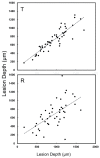Measurement of the Depth of Lesions on Proximal Surfaces with SWIR Multispectral Transillumination and Reflectance Imaging
- PMID: 35328150
- PMCID: PMC8947190
- DOI: 10.3390/diagnostics12030597
Measurement of the Depth of Lesions on Proximal Surfaces with SWIR Multispectral Transillumination and Reflectance Imaging
Abstract
The aim of this study was to compare the diagnostic performance of dual short-wavelength infrared (SWIR) transillumination and reflectance multispectral imaging devices for imaging interproximal lesions with radiography using extracted teeth that had been imaged with micro-computed tomography (microCT). Thirty-six extracted teeth with 67 lesions on the proximal surfaces were imaged using a newly fabricated SWIR multispectral proximal transillumination and reflectance imaging device along with an existing SWIR multispectral occlusal transillumination and reflectance device. The ability of SWIR imaging and radiography to detect lesions and accurately assess lesion dimensions were compared using microCT as a standard. Occlusal and proximal transillumination and occlusal reflectance performed best for imaging interproximal lesions while proximal reflectance was not useful for imaging interproximal lesions from tooth buccal and lingual surfaces. There was high correlation of the lesion dimensions measured in occlusal and proximal transillumination images compared to microCT and moderate correlation in occlusal reflectance images. The correlation between the lesion depth measured in radiographs and the lesion depth measured with microCT was not significant. This study demonstrates that SWIR occlusal and proximal transillumination and SWIR occlusal reflectance images are useful for imaging interproximal lesions and they provide more accurate measurements of lesion severity.
Keywords: SWIR imaging; caries detection; reflectance; transillumination.
Conflict of interest statement
The authors declare no conflict of interest.
Figures








References
-
- Jones G., Jones R.S., Fried D. Transillumination of interproximal caries lesions with 830-nm light; Proceedings of the Lasers in Dentistry X, Proc SPIE; San Jose, CA, USA. 28 May 2004; pp. 17–22.

